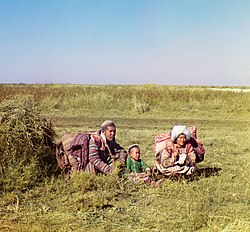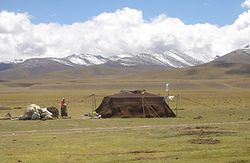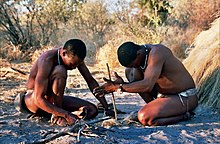游居文化



游居文化(英语:nomad)或非定居民族指频繁从一处移居到另一处、甚少定居于一地的族群,主要包括狩猎采集者和游牧者两类,但有时还包括提供手艺或经商的非定居民族,如吉普赛人、数字游民等[1][2]。与之相对的概念是定居文化。20世纪末绝大多数非定居民族都进行游牧,据估计到1995年全世界有3到4千万游牧民[3][4]。
狩猎采集指的是依季节性规律采集野菜、野菇、食用昆虫和野味的生活,这是最早发展出来的人类生活方式[5],这类社会广泛分布于世界各地[6]。
游牧则指在一定的地理范围内驱赶或陪伴一种或几种食草牲畜,通过移动的方式间隔某种周期反复利用牧场而获得生活资源的畜牧生产方式,且往往需要避免牧场达到其自然承载极限[7]。这类社会主要分布于环境生产力较低的干草原和沙漠[6]。
狩猎采集民族
|
主条目:狩猎采集 |

狩猎采集指的是依季节性规律采集野果、追捕猎物的生活,这是最早发展出来的人类生活方式[5]。
一部分狩猎采集文化后来转向农耕或畜牧。在现代只有相对少数的人口保持狩猎采集的生活方式。
现代狩猎采集民族例子
游牧民族



游牧则指在不同的牧场之间迁徙放牧的生活方式,与狩猎采集最显著的差异之一在于牲畜的驯养。通常认为游牧经历了三个发展阶段,其中伴随着人口的增长和社会组织的复杂性的增加。Karim Sadr提出了以下阶段[9]:
- 畜牧
- 农牧
- 真正意义上的游牧:在这一阶段分化出了专门的农耕人口和游牧人口。
畜牧者随着季节的变化(春夏秋冬或者旱季雨季)而迁徙至某些固定的区域并临时定居;而真正意义上的游牧则只取决于资源的有无[10]。
游牧的起源
游牧是新石器革命和农业兴起的结果。在新石器革命中,人类开始驯养动植物作为食物,并开始形成城市。游牧者通常与这种定居的文化共存,用动物产品(肉、皮、毛、奶酪和其他动物产品)从定居者手中换取他们无法生产的制成品。亨利·弗莱施初步认为,黎巴嫩新石器时代牧羊产业或许可追溯到后旧石器时代,且可能已存在于贝卡谷地的首批牧羊文化之一[11][12]。安德鲁·谢拉特(Andrew Sherratt)证明“早期的农业人口主要将牲畜用于肉食,并且随着农业逐渐适应新条件,特别是在半干旱地区,人们探索了其他用途。”[13]。
亚欧大陆最早的游牧社会形成于公元前8500到前6500年的黎凡特[14],由于土地变得越来越贫瘠,西奈半岛的前陶器时代B农耕文化被一个游牧的、制陶的文化所取代[15]。
可能与原始闪米特人群有关的环阿拉伯游牧文化群形成后[16],游牧传播至欧亚大草原,催生了颜那亚文化以及后来内亚的诸多游牧社会[15]。
在南部非洲一些地区,欧洲殖民者的后代曾形成了一个游牧民族特雷克布尔人[17]。
游牧民族
现代游牧民族例子
- 非洲
- 欧洲
中国历史上的游牧民族
在中国历史上,进入农业社会以后,汉族地区的汉族人以农耕为生,将漠北草原的游牧民族及西域的族群统称为胡人。
在中国历史上出现过的游牧民族有:
- 蒙古
- 匈奴
- 月氏
- 鲜卑
- 乌桓
- 羯(不确定)
- 氐(部分)
- 羌(部分)
- 戎
- 柔然
- 突厥
- 党项(弥药)(东迁银夏五州后部分转农耕)
- 回纥(回鹘)(西迁后部分转农耕)
- 库莫奚
- 契丹 (半农半牧)
- 乌孙
- 塞种
- 康居
容易被误认为属于游牧民族的民族
- 女真(渔猎民族)
- 满洲(渔猎民族)
- 维吾尔(农耕民族)
- 乌兹别克(农耕民族)
- 普什图(农耕民族):《清史稿·属国传》记载阿富汗“人皆土著,业农,无游牧。”
- 法兰克(农耕民族):《萨利克法典》有“擅自翻耕他人土地的罚款15金币,翻耕后又私自播种的罚款45金币”“如果有猪或其它牲畜跑到别人谷田中,牲畜的主人罚款15金币”等保护农田耕地之规定。
- 鞑靼族(农耕民族)
- 塔吉克族(农耕民族)
- 达斡尔族(农耕民族兼事渔猎)
- 土库曼人(主要在沙漠绿州中农耕)
中国草原、农业民族比较
| 项目 | 游牧民族 | 农业民族 |
|---|---|---|
| 主要生活区 | 戈壁以北 | 戈壁以南 |
| 经济生活 | 以游牧为主 | 以农耕为主 |
| 政府组织 | 国家权力较分散,统治者通常为军事和部落首领 | 国家权力较集中 |
其他非定居民族
有一些族群通过提供某种手艺或进行贸易在各地流动。他们往往会多种语言,只进行内部通婚。其中最典型的例子有罗姆人(又称吉普赛人)、多姆人、现代月氏人、尤鲁克人等。
海上游居者
在东南亚地区有一些民族在海上进行游居,包括巴瑶族、莫肯人、罗越人、蜑家等。多数从事渔业,也有些从事贸易。这种生活方式有时因频繁进出国界,加上国籍和户籍问题,而受到国家政府的干预。
现代社会衍生
参考资料
- ^ Columbia Electronic Encyclopedia. [2020-07-11]. (原始内容存档于2021-04-28).
- ^ Encyclopaedia Britannica. [2020-07-11]. (原始内容存档于2021-05-05).
- ^ Annamoradnejad, Rahimberdi; Lotfi, Sedigheh. Demographic changes of nomadic communities in Iran (1956–2008). Asian Population Studies. 2010, 6 (3): 335–45. doi:10.1080/17441730.2010.512764.
- ^ Nomads: At the Crossroads – The Facts. New Internationalist. April 5, 1995, (266) [2020-07-11]. (原始内容存档于2021-04-28).
- ^ 5.0 5.1 Subsistence. explorable.com. [2019-02-24]. (原始内容存档于2021-04-26).
- ^ 6.0 6.1 Gavin, Michael C.; Kavanagh, Patrick H.; Haynie, Hannah J.; Bowern, Claire; Ember, Carol R.; Gray, Russell D.; Jordan, Fiona M.; Kirby, Kathryn R.; Kushnick, Geoff; Low, Bobbi S.; Vilela, Bruno. The global geography of human subsistence. Royal Society Open Science. 2018-09, 5 (9) [2024-02-07]. ISSN 2054-5703. PMC 6170550
 . PMID 30839689. doi:10.1098/rsos.171897. (原始内容存档于2022-10-24) (英语).
. PMID 30839689. doi:10.1098/rsos.171897. (原始内容存档于2022-10-24) (英语).
- ^ Homewood, Katherine; Rodgers, W.A., Pastoralism, conservation and the overgrazing controversy, Conservation in Africa (Cambridge University Press), 1988-01-21: 111–128 [2020-05-27], ISBN 978-0-521-34199-8
- ^ Your pictures: Ed Vallance. BBC News – In Pictures. 2008-09-23 [29 April 2015]. (原始内容存档于2021-03-12).
- ^ Yee, Danny. The Development of Nomadism in Ancient Northeast Africa Karim Sadr [Book Review]. 1991. (原始内容存档于2021-03-12).
- ^ Nomads of the Middle East 互联网档案馆的存档,存档日期2009-04-28., David Zeidan, OM-IRC, 1995
- ^ L. Copeland; P. Wescombe. Inventory of Stone-Age Sites in Lebanon: North, South and East-Central Lebanon, p. 49. Impr. Catholique. 1966 [29 August 2011]. (原始内容存档于2021-03-12).
- ^ Fleisch, Henri., Notes de Préhistoire Libanaise : 1) Ard es Saoude. 2) La Bekaa Nord. 3) Un polissoir en plein air. BSPF, vol. 63, 1966.
- ^ Sherratt, Andrew (1983), "The secondary exploitation of animals in the Old World" in (World Archaeology Volume 15, Issue 1, 1983 Special Issue: Transhumance and pastoralism)
- ^ Ning, Shi; Dupont, Lydie M. Vegetation and climatic history of southwest Africa: A marine palynological record of the last 300,000 years. Vegetation History and Archaeobotany. June 1997, 6 (2): 117–131. ISSN 0939-6314. doi:10.1007/bf01261959.
- ^ 15.0 15.1 Patterns of Subsistence: Pastoralism. [2020-07-11]. (原始内容存档于2016-02-03).
- ^ Zarins, Juris (1992) "Pastoral Nomadism in Arabia: Ethnoarchaeology and the Archaeological Record," in O. Bar-Yosef and A. Khazanov, eds. "Pastoralism in the Levant"
- ^ Fouché, Leo. V: Foundation of the Cape Colony, 1652–1708. Walker, Eric Anderson (编). The Cambridge History of the British Empire. VIII: South Africa, Rhodesia and the Protectorates. Cambridge: CUP Archive. 1936: 1361963 [2016-11-16]. (原始内容存档于2021-03-12).
[...] van der Stel recognised the roving tendency among the colonists and tried to arrest it. A proclamation of 1692 illustrated his fears: it stated that colonists were making a living by grazing cattle and bartering in the interior [...]. This seems clear proof that the trekboer, as a distinct type, was coming into existence during the time of van der Stel. [...] Generation after generation of these hardy and self-reliant nomads pushed the frontiers of civilisation further into the wilderness.
参考书目
- Denis Sinor著,罗新等译:《丹尼斯.塞诺内亚研究文选》(北京:中华书局,2006)。
外部链接
- 赵鼎新:〈游牧民族与中原帝国竞争的中国历史〉 (页面存档备份,存于互联网档案馆)(2014)
| |||||||||||||||||
Text is available under the CC BY-SA 4.0 license; additional terms may apply.
Images, videos and audio are available under their respective licenses.
